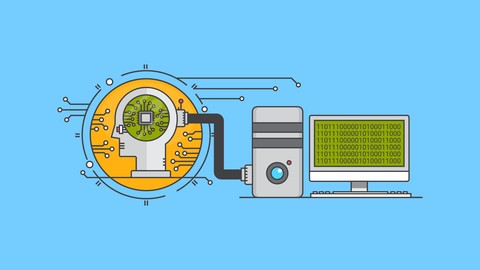
Machine Learning with Python, scikit-learn and TensorFlow
Machine Learning with Python, scikit-learn and TensorFlow, available at $19.99, has an average rating of 2.95, with 111 lectures, based on 23 reviews, and has 187 subscribers.
You will learn about Solve interesting, real-world problems using machine learning with Python Evaluate the performance of machine learning systems in common tasks Create pipelines to deal with real-world input data Traverse from concept to a production-ready machine learning setup/pipeline capable of real-world usage Use Python to visualize data spread across multiple dimensions and extract useful features to implement machine learning classification and regression algorithms from scratch in Python Predict the values of continuous variables using linear regression and K Nearest Neighbors to classify documents and images using logistic regression and support vector machines This course is ideal for individuals who are Anyone interested in entering the data science stream with Machine Learning. or Software engineers who want to understand how common Machine Learning algorithms work. or Data scientists and researchers who want to learn about the scikit-learn API. It is particularly useful for Anyone interested in entering the data science stream with Machine Learning. or Software engineers who want to understand how common Machine Learning algorithms work. or Data scientists and researchers who want to learn about the scikit-learn API.
Enroll now: Machine Learning with Python, scikit-learn and TensorFlow
Summary
Title: Machine Learning with Python, scikit-learn and TensorFlow
Price: $19.99
Average Rating: 2.95
Number of Lectures: 111
Number of Published Lectures: 111
Number of Curriculum Items: 111
Number of Published Curriculum Objects: 111
Original Price: $199.99
Quality Status: approved
Status: Live
What You Will Learn
- Solve interesting, real-world problems using machine learning with Python
- Evaluate the performance of machine learning systems in common tasks
- Create pipelines to deal with real-world input data
- Traverse from concept to a production-ready machine learning setup/pipeline capable of real-world usage
- Use Python to visualize data spread across multiple dimensions and extract useful features to implement machine learning classification and regression algorithms from scratch in Python
- Predict the values of continuous variables using linear regression and K Nearest Neighbors to classify documents and images using logistic regression and support vector machines
Who Should Attend
- Anyone interested in entering the data science stream with Machine Learning.
- Software engineers who want to understand how common Machine Learning algorithms work.
- Data scientists and researchers who want to learn about the scikit-learn API.
Target Audiences
- Anyone interested in entering the data science stream with Machine Learning.
- Software engineers who want to understand how common Machine Learning algorithms work.
- Data scientists and researchers who want to learn about the scikit-learn API.
Machine learning brings together computer science and statistics to build smart, efficient models. Using powerful techniques offered by machine learning, you’ll tackle data-driven problems. The effective blend of Machine Learning with Python, scikit-learn, and TensorFlow, helps in implementing solutions to real-world problems as well as automating analytical model.
This comprehensive 3-in-1 course is your one-stop solution in mastering machine learning algorithms and their implementation. Learn the fundamentals of machine learning and build your own intelligent applications. Explore popular machine learning models including k-nearest neighbors, random forests, logistic regression, k-means, naive Bayes, and artificial neural networks
Contents and Overview
This training program includes 3 complete courses, carefully chosen to give you the most comprehensive training possible.
This course will help you discover the magical black box that is Machine Learning by teaching a practical approach to modeling using Python, scikit-learn and TensorFlow.
The first course, Step-by-Step Machine Learning with Python, covers easy-to-follow examples that get you up and running with machine learning. In this course, you’ll learn all the important concepts such as exploratory data analysis, data preprocessing, feature extraction, data visualization and clustering, classification, regression, and model performance evaluation. You’ll build your own models from scratch.
The second course, Machine Learning with Scikit-learn, covers effective learning algorithms to real-world problems using scikit-learn. You’ll build systems that classify documents, recognize images, detect ads, and more. You’ll learn to use scikit-learn’s API to extract features from categorical variables, text and images; evaluate model performance; and develop an intuition for how to improve your model’s performance.
The third course, Machine Learning with TensorFlow, covers hands-on examples with machine learning using Python. You’ll cover the unique features of the library such as data flow Graphs, training, and visualization of performance with TensorBoard—all within an example-rich context using problems from multiple sources.. The focus is on introducing new concepts through problems that are coded and solved over the course of each section.
By the end of this training program you’ll be able to tackle data-driven problems and implement your solutions as well as build efficient models with the powerful yet simple features of Python, scikit-learn and TensorFlow.
About the Authors
- Yuxi (Hayden) Liuis currently an applied research scientist focused on developing machine learning models and systems for given learning tasks. He has worked for a few years as a data scientist, and applied his machine learning expertise in computational advertising. He earned his degree from the University of Toronto, and published five first-authored IEEE transaction and conference papers during his research. His first book, titled Python Machine Learning By Example, was ranked the #1 bestseller in Amazon India in 2017. He is also a machine learning education enthusiast.
- Shams Ul Azeemis an undergraduate in electrical engineering from NUST Islamabad, Pakistan. He has a great interest in the computer science field, and he started his journey with Android development. Now, he’s pursuing his career in Machine Learning, particularly in deep learning, by doing medical-related freelancing projects with different companies. He was also a member of the RISE lab, NUST, and he has a publication credit at the IEEE International Conference, ROBIO as a co-author of Designing of motions for humanoid goalkeeper robots.
Course Curriculum
Chapter 1: Step-by-Step Machine Learning with Python
Lecture 1: The Course Overview
Lecture 2: Introduction to Machine Learning
Lecture 3: Installing Software and Setting Up
Lecture 4: Understanding NLP
Lecture 5: Touring Powerful NLP Libraries in Python
Lecture 6: Getting the Newsgroups Data
Lecture 7: Thinking about Features
Lecture 8: Visualization
Lecture 9: Data Preprocessing
Lecture 10: Clustering
Lecture 11: Topic Modeling
Lecture 12: Getting Started with Classification
Lecture 13: Exploring Naïve Bayes
Lecture 14: The Mechanics of Naïve Bayes
Lecture 15: The Naïve Bayes Implementation
Lecture 16: Classifier Performance Evaluation
Lecture 17: Model Tuning and cross-validation
Lecture 18: Recap and Inverse Document Frequency
Lecture 19: The Mechanics of SVM
Lecture 20: The Implementations of SVM
Lecture 21: The Kernels of SVM
Lecture 22: Choosing Between the Linear and the RBF Kernel
Lecture 23: News topic Classification with Support Vector Machine
Lecture 24: Fetal State Classification with SVM
Lecture 25: Brief Overview of Advertising Click-Through Prediction
Lecture 26: Decision Tree Classifier
Lecture 27: The Implementations of Decision Tree
Lecture 28: Click-Through Prediction with Decision Tree
Lecture 29: Random Forest – Feature Bagging of Decision Tree
Lecture 30: One-Hot Encoding – Converting Categorical Features to Numerical
Lecture 31: Logistic Regression Classifier
Lecture 32: Click-Through Prediction with Logistic Regression by Gradient Descent
Lecture 33: Feature Selection via Random Forest
Lecture 34: Brief Overview of the Stock Market And Stock Price
Lecture 35: Predicting Stock Price with Regression Algorithms
Lecture 36: Data Acquisition and Feature Generation
Lecture 37: Linear Regression
Lecture 38: Decision Tree Regression
Lecture 39: Support Vector Regression
Lecture 40: Regression Performance Evaluation
Lecture 41: Stock Price Prediction with Regression Algorithms
Lecture 42: Best Practices in Data Preparation Stage
Lecture 43: Best Practices in the Training Sets Generation Stage
Lecture 44: Best Practices in the Model Training, Evaluation, and Selection Stage
Lecture 45: Best Practices in the Deployment and Monitoring Stage
Chapter 2: Machine Learning with Scikit-learn
Lecture 1: The Course Overview
Lecture 2: Defining Machine Learning
Lecture 3: Training Data, Testing Data, and Validation Data
Lecture 4: Bias and Variance
Lecture 5: An Introduction to Scikit-learn
Lecture 6: Installing Pandas, Pillow, NLTK, and Matplotlib
Lecture 7: What Is Simple Linear Regression?
Lecture 8: Evaluating the Model
Lecture 9: KNN, Lazy Learning, and Non-Parametric Models
Lecture 10: Classification with KNN
Lecture 11: Regression with KNN
Lecture 12: Extracting Features from Categorical Variables
Lecture 13: Standardizing Features
Lecture 14: Extracting Features from Text
Lecture 15: Multiple Linear Regression
Lecture 16: Polynomial Regression
Lecture 17: Regularization
Lecture 18: Applying Linear Regression
Lecture 19: Gradient Descent
Lecture 20: Binary Classification with Logistic Regression
Lecture 21: Spam Filtering
Lecture 22: Tuning Models with Grid Search
Lecture 23: Multi-Class Classification
Lecture 24: Multi-Label Classification and Problem Transformation
Lecture 25: Bayes' Theorem
Lecture 26: Generative and Discriminative Models
Lecture 27: Naive Bayes with Scikit-learn
Lecture 28: Decision Trees
Lecture 29: Training Decision Trees
Lecture 30: Decision Trees with Scikit-learn
Lecture 31: Bagging
Lecture 32: Boosting
Lecture 33: Stacking
Lecture 34: The Perceptron–Basics
Lecture 35: Limitations of the Perceptron
Lecture 36: Kernels and the Kernel Trick
Lecture 37: Maximum Margin Classification and Support Vectors
Lecture 38: Classifying Characters in Scikit-learn
Lecture 39: Nonlinear Decision Boundaries
Lecture 40: Feed-Forward and Feedback ANNs
Lecture 41: Multi-Layer Perceptrons and Training Them
Lecture 42: Clustering
Lecture 43: K-means
Lecture 44: Evaluating Clusters
Lecture 45: Image Quantization
Lecture 46: Principal Component Analysis
Lecture 47: Visualizing High-Dimensional Data and Face Recognition with PCA
Chapter 3: Machine Learning with TensorFlow
Lecture 1: The Course Overview
Lecture 2: Introducing Deep Learning
Lecture 3: Installing TensorFlow on Mac OSX
Lecture 4: Installation on Windows – Pre-Reqeusite Virtual Machine Setup
Lecture 5: Installation on Windows/Linux
Instructors
-
Packt Publishing
Tech Knowledge in Motion
Rating Distribution
- 1 stars: 3 votes
- 2 stars: 4 votes
- 3 stars: 6 votes
- 4 stars: 4 votes
- 5 stars: 6 votes
Frequently Asked Questions
How long do I have access to the course materials?
You can view and review the lecture materials indefinitely, like an on-demand channel.
Can I take my courses with me wherever I go?
Definitely! If you have an internet connection, courses on Udemy are available on any device at any time. If you don’t have an internet connection, some instructors also let their students download course lectures. That’s up to the instructor though, so make sure you get on their good side!
You may also like
- Top 10 Financial Technology Courses to Learn in December 2024
- Top 10 Agile Methodologies Courses to Learn in December 2024
- Top 10 Project Management Courses to Learn in December 2024
- Top 10 Leadership Skills Courses to Learn in December 2024
- Top 10 Public Speaking Courses to Learn in December 2024
- Top 10 Affiliate Marketing Courses to Learn in December 2024
- Top 10 Email Marketing Courses to Learn in December 2024
- Top 10 Social Media Management Courses to Learn in December 2024
- Top 10 SEO Optimization Courses to Learn in December 2024
- Top 10 Content Creation Courses to Learn in December 2024
- Top 10 Game Development Courses to Learn in December 2024
- Top 10 Software Testing Courses to Learn in December 2024
- Top 10 Big Data Courses to Learn in December 2024
- Top 10 Internet Of Things Courses to Learn in December 2024
- Top 10 Quantum Computing Courses to Learn in December 2024
- Top 10 Cloud Computing Courses to Learn in December 2024
- Top 10 3d Modeling Courses to Learn in December 2024
- Top 10 Mobile App Development Courses to Learn in December 2024
- Top 10 Graphic Design Courses to Learn in December 2024
- Top 10 Videography Courses to Learn in December 2024






















